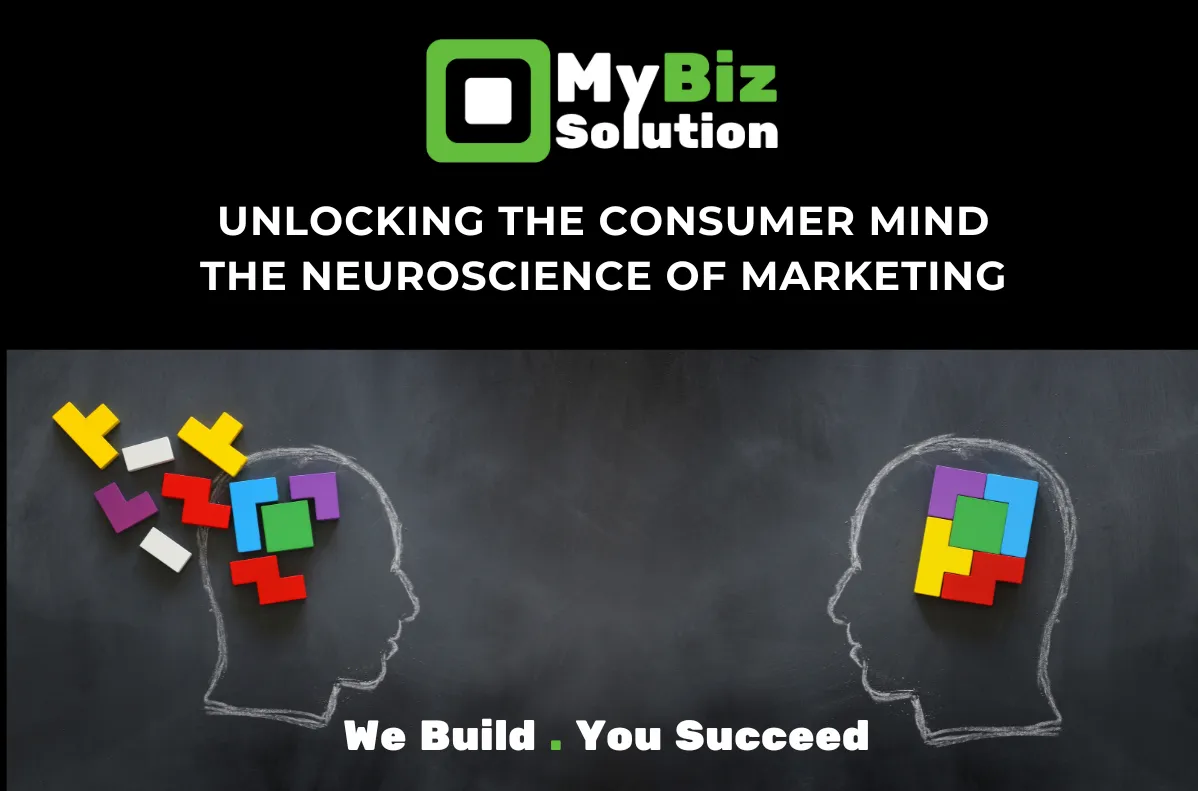
Unlocking The Consumer Mind
The Neuroscience of Marketing
MyBiz Solution is at the cutting edge of business software solutions. With all aspects of your business integrated into one, easy-to-use platform, we are changing the way small businesses operate. I personally find assisting businesses with marketing a particularly fascinating area, and I have previously written about the Psychology of Marketing and what drives consumer choices. Following on from our conversations about that article, I wanted to take this a step further.
In today's competitive business landscape, small businesses are increasingly looking for ways to stand out from the crowd, and ‘neuromarketing’ is a way to gain deeper insights into consumer behaviour. Neuromarketing, as you would expect, combines neuroscience with marketing research, providing businesses with a scientific approach to understanding consumer decision-making processes. By utilising advanced brain imaging techniques, we can gain invaluable insights into the subconscious factors that drive consumer preferences and purchasing decisions. The good news is that you don’t have to be a scientist to implement this; the research is there, you just have to explore how to use it. This article will hopefully provide you with some insights and useful, actionable tips for small businesses to stand out in a crowded space.
Contents
Neuroscience of Marketing
Attention and Perception
Memory and Branding
Emotional Engagement
Cognitive Biases in Marketing
Visual and Verbal Processing
Digital Marketing and Technology
Ethical Implications
Future Directions
Neuroscience of Marketing: Decoding the Consumer Brain
Small businesses can benefit from numerous studies in the field of neuromarketing that shed light on consumer behaviour. For instance, research found that emotional engagement plays a crucial role in consumer decision-making, with emotionally resonant advertisements leading to higher levels of brand recall and preference. This may come as no surprise, as we are all aware of the long term impacts emotions can have on us, which therefore underscores the importance of crafting emotionally compelling marketing campaigns that resonate with consumers on a deeper level.
For example, in the hospitality industry, creating memorable experiences is essential for building customer loyalty and driving repeat business. Neuromarketing can help hotels, restaurants, and travel companies understand the emotional triggers that influence booking decisions and customer satisfaction. By crafting marketing campaigns and messaging that evoke positive emotions, businesses can enhance the overall customer experience and differentiate themselves from competitors.
In the healthcare industry, building trust and credibility is key, and knowing about your clients perceptions and preferences can help tailor your marketing and services, leading to better outcomes for clients and your business. This is applicable in all industries; in the financial services industry, establishing trust and confidence is essential for attracting and retaining customers. Neuromarketing can help banks, insurance companies, and investment firms understand the underlying emotions and cognitive biases that influence financial decision-making, enabling them to create marketing materials and messaging that resonate with consumers' values and concerns.
Even in the tech sector, for companies like MyBiz Solution, understanding user behaviour and preferences is crucial for product development and marketing success. Neuromarketing can provide us with insights into how consumers interact with digital products and platforms, allowing us to optimise user experiences and provide products and services specific to the client.

Key Takeaways for Small Businesses:
Utilise neuromarketing research findings to inform marketing strategies and campaign development.
Prioritise emotional engagement in advertising efforts to enhance brand recall and preference.
Consider conducting localised neuromarketing studies to gain insights into specific target markets.
Attention and Perception: Capturing the Consumer's Gaze
Did you know it takes only 13 milliseconds for the human brain to process an image. It makes sense, then, that website visitors only spend an average of 5.59 seconds looking at written content on a site.
The human brain processes images 60,000 times faster than text; therefore, it’s no surprise that incorporating visually appealing elements into marketing materials will capture attention and convey key messages quickly; including videos on a website can increase time spent on page by a massive 88%.
I have come across thousands of different learners and used many strategies and methods to tailor learning specifically to their individual needs. On the whole, research by the Nielsen Norman Group confirmed a growing trend we have witnessed: that we have increasingly less patience with text. They found that people only read an average of 28% of words on a webpage (I know, you poured your heart and soul into that content!) and a staggering 82% would rather watch a video on social media than read a post. This is a huge area and something to explore in much more detail in another article but here are some key things for small businesses to consider.

Key Takeaways for Small Businesses:
Optimise marketing materials with visually engaging elements such as high-quality images and video content.
Use eye-catching design techniques to draw attention to important information or calls to action.
Test, test and test again different visual elements to identify what resonates best with your target audience.
Memory and Branding: Forging Lasting Impressions
Last week, I felt very proud of my super-sleuth detective skills. I found a tiny piece of cardboard on the floor in my hallway and instantly knew someone had had a breakfast wrap from MacDonald’s. Now I shouldn’t get carried away with myself, as this is an example of the significant role that memory encoding plays in brand recall and recognition. Brands that consistently reinforce their messaging through repeated exposure create stronger associations in consumers' minds, increasing the likelihood of being stored in long-term memory. This means that when consumers encounter a product or service associated with the brand, they are more likely to recall relevant information, such as the brand name, logo, or key attributes.
For small businesses, this insight is invaluable, as it emphasises the importance of developing cohesive branding strategies that are consistently applied across all marketing channels. By maintaining consistency in branding elements such as logos, colours, fonts, and messaging, small businesses can reinforce brand identity and create strong associations with their target audience. Whether through digital marketing, social media, print advertising, or in-store experiences, every touchpoint should reflect the brand's values and positioning consistently. This also helps enhance brand recall among consumers, making it easier for them to recognise and remember the brand in the future (not such a super sleuth after all!). When consumers are bombarded with numerous advertising messages daily, this can be highly effective. Small businesses that invest in developing and maintaining a cohesive brand identity stand a better chance of cutting through the clutter and making a lasting impression on consumers.

Key Takeaways for Small Businesses:
Invest in brand consistency across all marketing touchpoints, including the logo, colours, and messaging.
Utilise repetition and reinforcement techniques to strengthen memory encoding and recall.
Create memorable brand experiences through storytelling and experiential marketing initiatives.
Emotional Engagement: Connecting on a Deeper Level
Emotional engagement is a powerful driver of consumer behaviour. Emotionally resonant advertisements elicit stronger neural responses and lead to higher levels of brand affinity and loyalty. These heightened neural responses are indicative of increased attention, arousal, and engagement, suggesting that emotionally engaging content captures consumers' interest more effectively. When consumers experience emotions such as joy, surprise, or nostalgia in response to marketing stimuli, they are more likely to form positive associations with the brand and develop a stronger affinity for it.
For small businesses, tapping into consumers' emotions can be a powerful strategy for building meaningful relationships with their target audience. By creating authentic connections and eliciting emotional responses through marketing campaigns, small businesses can differentiate themselves from competitors and stand out in a crowded marketplace. Whether through storytelling, imagery, or brand messaging, businesses can evoke emotions that resonate with their audience's values, aspirations, and experiences.
Forging deeper emotional connections with consumers can help foster loyalty and advocacy, ultimately driving long-term success and sustainable growth. Emotionally engaged customers are more likely to remain loyal to a brand, advocate for it among their peers, and even forgive occasional shortcomings or mistakes. Therefore, by prioritising emotional engagement in their marketing efforts, small businesses can cultivate a loyal customer base and establish themselves as trusted brands in their respective industries.

Key Takeaways for Small Businesses:
Develop marketing campaigns that evoke specific emotions aligned with your brand's values and messaging.
Incorporate storytelling and narrative-driven content to create emotional connections with consumers.
Foster engagement and interaction through user-generated content and community-building initiatives.
Cognitive Biases in Marketing: Navigating the Mental Minefield
Cognitive biases are inherent flaws or shortcuts in human reasoning that influence decision-making processes. These biases often operate at a subconscious level, shaping individuals' perceptions, judgements, and behaviours in predictable ways. For small businesses, understanding these cognitive biases is invaluable, as it allows them to tailor their marketing strategies to align with consumers' subconscious preferences and motivations.
There are various cognitive biases that are prevalent in decision-making contexts. Two examples of such biases are the anchoring effect and social proof.
Anchoring Effect: This bias occurs when individuals rely heavily on the first piece of information encountered (the "anchor") when making subsequent judgements or decisions. For example, if a product is initially presented with a high price, consumers may perceive subsequent, lower prices as more reasonable or attractive. Small businesses can leverage the anchoring effect by strategically framing pricing information or product features to influence consumers' perceptions of value.
Social Proof: Social proof refers to the tendency for individuals to conform to the actions or opinions of others, particularly in ambiguous or uncertain situations. When consumers observe others endorsing or engaging with a product or brand, they are more likely to perceive it positively and follow suit. You cannot help but notice the increased presence of ‘influencers’ these days, who would have thought years ago that would be an actual job! Small businesses can leverage social proof by showcasing customer testimonials, user reviews, or social media endorsements to validate their products or services and instil confidence in prospective customers.
By understanding and leveraging these cognitive biases ethically and responsibly, small businesses can influence consumer perceptions and behaviours in their favour by designing more effective marketing strategies that resonate with consumers' subconscious preferences and motivations. For example, they can design marketing messages that align with consumers' existing beliefs or preferences, making them more persuasive and compelling. However, it's essential for businesses to use these techniques transparently and avoid manipulating or deceiving consumers.

Key Takeaways for Small Businesses:
● Familiarise yourself with common cognitive biases and how they manifest in consumer decision-making.
● Tailor marketing messages and promotions to align with consumers' cognitive biases and decision heuristics.
Test different messaging strategies to identify which resonates most effectively with your target audience.
Visual and Verbal Processing: Finding the Right Balance
Balancing visual and verbal communication is crucial for small businesses to create impactful marketing materials that effectively engage consumers. By understanding the importance of how the brain processes different types of information, we can tailor marketing strategies.
As previously mentioned, the brain processes visual information significantly faster than text-based information. However, while visuals are powerful for capturing attention, they may not always convey complex messages or evoke emotional responses as effectively as verbal elements. This is where incorporating verbal communication, such as compelling storytelling or descriptive messaging, becomes essential. Verbal elements can add depth and context to marketing materials, allowing businesses to convey complex ideas, evoke emotions, and connect with consumers on a deeper level.
For example, storytelling is a powerful verbal communication tool that can humanise a brand, evoke emotions, and create memorable experiences for consumers. By weaving narratives into their marketing materials, small businesses can engage consumers emotionally, build brand affinity, and differentiate themselves from competitors. (You all are now aware of my supersleuth abilities, or lack thereof.).
By leveraging both visual and verbal communication strategically, businesses can create compelling marketing materials that resonate with consumers and drive desired actions.

Key Takeaways for Small Businesses:
Optimise marketing materials with visually appealing elements to capture attention and convey key messages quickly.
Use storytelling and narrative-driven content to enhance engagement and create memorable brand experiences.
Ensure consistency between visual and verbal elements to reinforce messaging and brand identity.
Digital Marketing and Technology: Riding the Wave of Innovation
There are now an unprecedented number of opportunities to connect with consumers in ways that were previously inaccessible. With the proliferation of online channels and platforms, businesses have a multitude of avenues to reach and engage their target audience effectively. However, it's not just the sheer volume of digital spaces that presents opportunities; it's also the innovative technologies that are reshaping how businesses interact with consumers.
One such transformative technology is augmented reality (AR) and virtual reality (VR). These immersive technologies have the potential to revolutionise consumer engagement and brand experiences. AR overlays digital content onto the real world, enhancing the user's perception of reality, while VR creates entirely immersive virtual environments. Both technologies offer unique ways for businesses to captivate audiences and drive engagement.
For example, a furniture retailer could use AR technology to allow customers to visualise how a piece of furniture would look in their own home before making a purchase. Similarly, a travel agency could use VR to provide virtual tours of destinations, allowing customers to explore and experience different locations from the comfort of their own homes.
These immersive experiences not only captivate audiences but also foster deeper engagement with the brand. By offering consumers the opportunity to interact with products or services in a virtual environment, businesses can create memorable experiences that resonate with their target audience. Not ignoring, of course, the novelty and excitement surrounding such experiences and how they can generate buzz and word-of-mouth promotion, further extending the reach of the marketing campaign.
As these technologies continue to evolve, small businesses that stay ahead of the curve stand to reap significant rewards in terms of consumer engagement and market differentiation.

Key Takeaways for Small Businesses:
Embrace digital marketing channels and technologies to reach and engage with consumers effectively.
Experiment with innovative technologies such as AR and VR to create immersive brand experiences and differentiate yourself from competitors.
Leverage data analytics and insights from digital platforms to refine marketing strategies and optimise campaign performance.
Ethical Implications: Balancing Persuasion and Responsibility
Neuromarketing, with its ability to delve into the subconscious mind and uncover insights into consumer behaviour, holds significant promise for businesses seeking to understand and influence consumer decisions. However, along with its potential benefits, neuromarketing also raises important ethical considerations that must be addressed.
One of the primary ethical concerns surrounding neuromarketing is the issue of privacy. The use of advanced technologies to measure brain activity raises questions about the extent to which consumers' privacy is respected and protected. For example, if businesses collect neuroscientific data from individuals without their knowledge or consent, it could raise serious privacy concerns.
There is also a risk of manipulation inherent in neuromarketing practices. By tapping into subconscious desires and motivations, businesses may influence consumer behaviour in ways that individuals are not consciously aware of. This raises ethical questions about the boundaries of acceptable persuasion and the potential for exploitation.
For small businesses, navigating these ethical considerations is essential. While neuromarketing can offer valuable insights into consumer behaviour, businesses must ensure that their marketing practices are transparent, respectful, and responsible. This may involve being upfront with consumers about the use of neuromarketing techniques, obtaining their consent where necessary, and avoiding manipulative tactics that undermine consumer autonomy.

Key Takeaways for Small Businesses:
Prioritise ethical considerations in marketing research and practice, and adhere to industry guidelines and standards.
Respect consumer privacy and consent when collecting and analysing neuroscientific data.
Ensure transparency and accountability in marketing communications, and avoid deceptive or manipulative tactics.
Future Directions: Charting a Course for Innovation
The future of neuromarketing holds tremendous promise for small businesses, especially as technology continues to advance and our understanding of consumer behaviour becomes more sophisticated. Research from esteemed institutions continue to shed light on the potential of emerging technologies, such as artificial intelligence (AI) and predictive analytics, to reshape the landscape of marketing.
Artificial intelligence, with its ability to analyse vast amounts of data and identify patterns, offers small businesses unprecedented insights into consumer preferences, behaviours, and trends. MyBiz Solution helps small businesses leverage AI-powered tools and algorithms to gain a deeper understanding of their target audience, identify market opportunities, and personalise marketing strategies to better meet consumers' needs, all in one platform.
Predictive analytics is another transformative technology that holds immense potential for small businesses. By analysing historical data and identifying trends, predictive analytics can help businesses anticipate future market trends, consumer preferences, and purchasing behaviour. This allows businesses to proactively adapt their marketing strategies and stay ahead of the competition.
By harnessing the power of emerging technologies combined with the business software that MyBiz Solution provides, businesses can gain a competitive edge, optimise marketing efforts, and drive growth and profitability.
The future of neuromarketing holds exciting possibilities and by embracing innovation and leveraging emerging technologies, small businesses can unlock new opportunities for growth and success in an ever-evolving marketplace.
To explore how MyBiz Solution can support your business in harnessing the latest technology and providing your business with the tools to succeed, get in touch to arrange a free discovery call.
Reviews
Photos Courtesy of LinkeIn
Testimonials Courtesy of Go High Level

Debbie DuBois
Compass Marketing Creative
"I felt completely supported as soon as I join the platform...These guys care about my business and have taken my business to the next level. The technology is continuing to shift and change while getting better and better. They are providing new services and things that I love."

Debbie DuBois
Compass Marketing Creative
"I felt completely supported as soon as I join the platform...These guys care about my business and have taken my business to the next level. The technology is continuing to shift and change while getting better and better. They are providing new services aDividernd thing that I love."

Alex Schlinsky
Founder of Prospecting On Demand™
"I have personally provided HighLevel to all of my elite clients in my mentorship program, and they have been utilizing it for prospecting, sales, fulfillment, keeping clients longer, making sure prospects never slip through the cracks, and utilizing things to save their time. If you're considering using HighLevel, use it. It's going to help your business scale!"

Shaun Kirk
PT Practice Success Marketing Creative
"The degree of service and value is phenomenal. Anything that you can think of or dream of, then a few days later you find out that it is going to be released the next week. The amount of listening they do with their customers is amazing. WHO DOES THAT? I am eternally grateful for HighLevel!"

Alex Schlinsky
Founder of Prospecting On Demand™
"I have personally provided HighLevel to all of my elite clients in my mentorship program, and they have been utilizing it for prospecting, sales, fulfillment, keeping clients longer, making sure prospects never slip through the cracks, and utilizing things to save their time. If you're considering using HighLevel, use it. It's going to help your business scale!"

Shaun Kirk
PT Practice Success Marketing Creative
"The degree of service and value is phenomenal. Anything that you can think of or dream of, then a few days later you find out that it is going to be released the next week. The amount of listening they do with their customers is amazing. WHO DOES THAT? I am eternally grateful for HighLevel!"

Christine Seale
President & CEO of NerdLevel
"It's been a complete game-changer for me. We've built our whole business around HighLevel now. We'll never go back."

Christine Seale
President & CEO of NerdLevel
"It's been a complete game-changer for me. We've built our whole business around HighLevel now. We'll never go back."
We Build. You Succeed.
© Copyright 2024. My Biz Solution Ltd. All rights reserved. Terms of Service I Privacy Policy I Acceptable Use Policy
© 2025 My Biz Solution Ltd- All Rights Reserved



